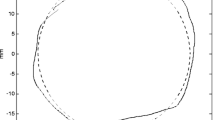Abstract
To address the hypothesis that Parkinson’s disease (PD) patients have deficits in controlling acceleration, a drawing task was used in which target size, frequency, and weight of pen were manipulated. In accordance with previous results, it was found that, relative to controls, PD patients produced movements at the required frequency, but moved significantly slower, produced less acceleration, and drew smaller-than-required stroke sizes. This resulted in smaller-than-required movement amplitudes, suggesting that hypometria and bradykinesia in drawing and/or handwriting are related. Patients were found to perform similarly to controls when the target size was 1 cm. However, their performance became more dissimilar at greater stroke lengths. In addition to the aforementioned effects it was found that movement amplitude error was less when the pen was 20 times heavier than the normal pen and that the increased load may dampen abnormal limb-stiffness characteristics induced by PD.



Similar content being viewed by others
References
Contreras-Vidal JL, Stelmach GE (1995) A neural model of basal ganglia–thalamocortical relations in normal and parkinsonian movement. Biol Cybern 73:467–476
De Jong WP, Hulstijn W, Kosterman BJM, Smits-Engelsman BCM (1996) OASIS software and its application in experimental handwriting research. In: Simner ML, Leedham CG, Thomassen AJWM (eds) Handwriting and drawing research: basic and applied issues. IOS Press, Amsterdam, pp 429–440
Ebersbach G, Sojer M, Valldeoriola J, Wissel J, Müller E, Tolosa E, Poewe W (1999) Comparative analysis of gait in Parkinson’s disease, cerebellar ataxia and subcortical arteriosclerotic encephalopathy. Brain 122:1349–1355
Folstein MF, Folstein SE, McHugh PR (1975) “Mini-Mental State”. A practical method for grading the cognitive state of patients for the clinician. J Psychol Res 2:189–198
Khudados E, Cody FW, O’Boyle DJ (1999) Proprioceptive regulation of voluntary ankle movements, demonstrated using muscle vibration, is impaired by Parkinson’s disease. J Neurol Neurosurg Psychiatry 67:504–510
Kunesch E, Schnitzler A, Tyercha C, Knecht S, Stelmach G (1995) Altered force release control in Parkinson’s disease. Behav Brain Res 67:43–49
Lacquaniti F, Ferrigno G, Pedotti A, Soechting JF, Terzuolo C (1987) Changes in spatial scale in drawing and handwriting: kinematic contributions by proximal and distal joints. J Neurosci 7:819–828
Margolin DI, Wing AM (1983) Agraphia and micrographia: clinical manifestations of motor programming and performance disorders. Acta Psychol 54:263–283
Marsden CD (1989) Slowness of movement in Parkinson’s disease. Mov Disord 4:S26–S35
McLennan JE, Nakano K, Tyler HR, Schwab RS (1972) Micrographia in Parkinson’s disease. J Neurol Sci 15:141–152
Pfann KD, Robichaud JA, Gottlieb GL, Comella CL, Brandabur M, Corcos DM (2004) Muscle activation patterns in point-to-point and reversal movements in healthy, older subjects and in subjects with Parkinson’s disease. Exp Brain Res 157:67–78
Poluha PC, Teulings H-L, Brookshire RH (1998) Handwriting and speech changes across the Levodopa cycle in Parkinson’s disease. Acta Psychol 100:71–84
Rickards C, Cody FW (1997) Proprioceptive control of wrist movements in Parkinson’s disease: reduced muscle vibration-induced errors. Brain 120:977–990
Robichaud JA, Pfann KD, Comella CL, Corcos DM (2002) Effect of medication on EMG patterns in individuals with Parkinson’s disease. Mov Disord 17:950–960
Stelmach GE, Worringham CJ (1988) The preparation and production of isometric force in Parkinson’s disease. Neuropsychologia 26:93–103
Stelmach GE, Teasdale N, Phillips J, Worringham CJ (1989) Force production characteristics in Parkinson’s disease. Exp Brain Res 76:165–172
Teulings H-L, Maarse FJ (1984) Digital recording and processing of handwriting movements. Hum Mov Sci 3:193–217
Teulings H-L, Stelmach GE (1991) Control of stroke size, peak acceleration, and stoke duration in Parkinsonian handwriting. Hum Mov Sci 10:314–333
Teulings H-L, Stelmach GE (1992) Simulation of impairment of force amplitude and force timing in Parkinsonian handwriting. In: Stelmach GE, Requin J (eds) Tutorials in motor behavior II. Elsevier, New York, pp 425–442
Teulings H-L, Contreras-Vidal JL, Stelmach GE, Adler CH (1997) Parkinsonism reduces coordination of fingers, wrist, and arm in fine motor control. Exp Neurol 146:159–170
Van Gemmert AWA, Teulings H-L, Stelmach GE (1998) The influence of mental and motor load on handwriting movements in Parkinsonian patients. Acta Psychol 100:161–175
Van Gemmert AWA, Teulings H-L, Contreras-Vidal JL, Stelmach GE (1999) Parkinson’s disease and the control of size and speed in handwriting. Neuropsychologia 37:685–694
Van Gemmert AWA, Teulings H-L, Stelmach GE (2001) Parkinsonian patients reduce their stroke size with increased processing demands. Brain Cogn 47:504–512
Van Gemmert AWA, Adler CH, Stelmach GE (2003) Parkinson’s disease patients undershoot target size in handwriting and similar tasks. J Neurol Neurosurg Psychiatry 74:1502–1508
Ventre-Dominey J, Dominey P-F, Broussole E (2002) Dissociable processing of temporal structure in repetitive eye–hand movements in Parkinson’s disease. Neuropsychologia 40:1407–1418
Wascher E, Verleger R, Vieregge P, Jaskowski P, Koch S, Kömpf D (1997) Responses to cued signals in Parkinson’s disease: distinguishing between disorders of cognition and of activation. Brain 120:1355–1375
Weiss P, Stelmach GE, Adler CH, Waterman C (1996) Parkinsonian arm movements as altered by task difficulty. Parkinsonism Relat Disord 2:215–223
Wing AM (1988) A comparison of the rate of pinch grip force increases and decreases in Parkinsonian bradykinesia. Neuropsychologia 26:479–482
Yahalom G, Simon ES, Thorne R, Peretz C, Gilado N (2004) Hand rhythmic tapping and timing in Parkinson’s disease. Parkinsonism Relat Disord 10:143–148
Acknowledgments
This research was supported by NINDS grants NS33173 and NS40266. Preliminary results were presented at the annual Society for Neuroscience conference, San Diego, CA, 2004. We thank the students, the elderly, and the Parkinson’s disease patients for their willingness to participate in this experiment. Furthermore, the authors are indebted to Kaushik Bhatt for Matlab programming.
Author information
Authors and Affiliations
Corresponding author
Rights and permissions
About this article
Cite this article
Broderick, M.P., Van Gemmert, A.W.A., Shill, H.A. et al. Hypometria and bradykinesia during drawing movements in individuals with Parkinson’s disease. Exp Brain Res 197, 223–233 (2009). https://doi.org/10.1007/s00221-009-1925-z
Received:
Accepted:
Published:
Issue Date:
DOI: https://doi.org/10.1007/s00221-009-1925-z




